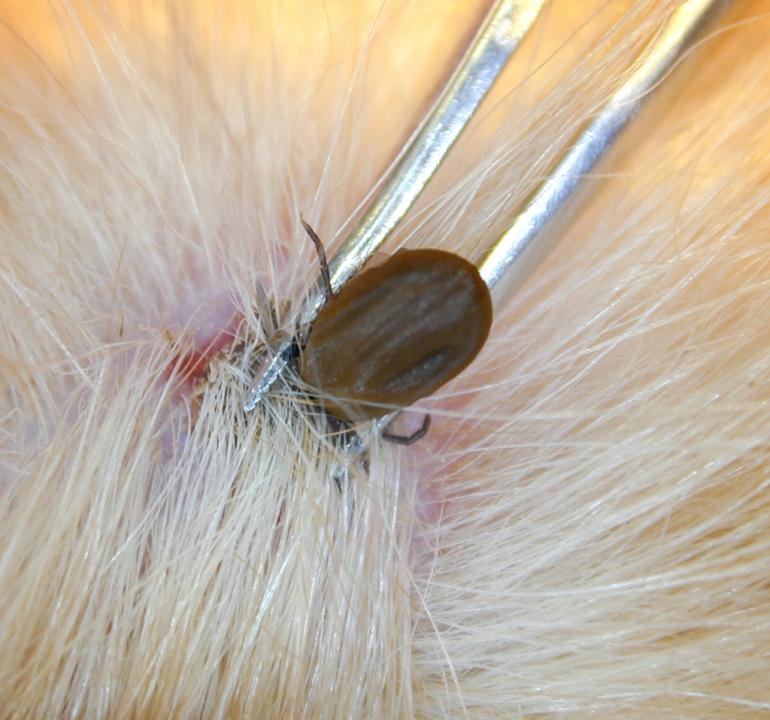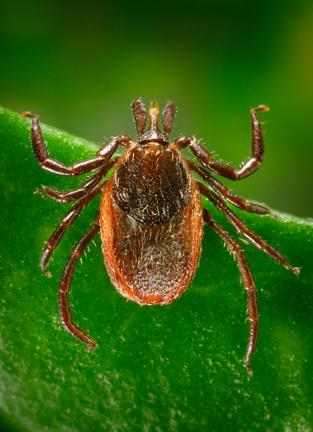Seasonal Uptick
Protect yourself from tick-borne illness this summer.
Tick check: the careful inspection of one’s arms, legs, pits, and scalp for ticks. It’s a task we woodland creatures need to do in the summer, especially after a wet spring, such as this one.
Ticks thrive in wet conditions, multiplying and lurking on grasses, in junipers, and in wooded areas. If you’re outdoors enough, there will come a time when you’ll have to pluck one of these small blood-sucking demons from your body. Ticks come in many sizes, all equally gross. But some carry nasty diseases, too, like the bacterial infection Lyme Disease.
I pulled one of these diseased suckers from my body when I was 10 years old. I reported it to my grandmother, and she marked the calendar hanging in her kitchen. Two weeks later I was sick, and a “bullseye” rash formed around the tick bite. The doctor down the street took a home visit and diagnosed the infection within minutes of seeing me. I started treatment that day. I was lucky to catch it early, but even so, I was on the couch and couldn’t eat solid food for a couple of weeks. It ruined applesauce for me. I mostly sweated and whimpered.
Don't let this happen to you. Follow these tips from the TickEncounter Resource Center and keep yourself safe from ticks this season.
Tick Prevention
From start to finish, Lyme Disease was a disgusting experience (I'll never wear bellbottoms in the woods again). There are ten tips to keep these disease-carrying, summer-ruining monsters off you.
1. Tick-repellent clothing. Many outdoor apparel brands, such as Insect Shield and ExOfficio, offer clothing treated with an insecticide called permethrin that repels and kills ticks.
2. Reduce the amount of exposed skin. Ticks can get onto your clothing, but they can’t get to your skin through clothing. Wear long pants, a long-sleeved shirt and a hat to keep them off your skin. (They can crawl to exposed areas, though, so always do a tick-check after an outing.)
3. EPA-approved insect repellent. Put it on.
4. Avoid brushing against foliage along trails. Stay off the game trails this season and walk in the center of established paths.
5. Tick-checks. Look for them while you’re outside and when you get back from being outside.
6. Shower. Maybe a tick is crawling around, looking for the perfect spot to dig in. Wash it off before it finds one.
7. Dry clothes on high heat. High heat for 30 minutes kills any ticks that may be on your clothes.
8. Inspect your pets. It can be hard to keep your pet out of tick-infested grasses and away from low-hanging tree limbs. Give them a good inspection after they’ve been outside—you don't want them passing the ticks on to you.
9. Opt for light-colored clothing. You can spot ticks easier that way.
10. Stay tucked. For an extra line of defense, tuck your shirt into your pants and pant legs into your socks when possible.
Disease Detection
Lyme Disease isn't always as easy to detect as my textbook example. According to the CDC, Lyme isn’t a life-long sentence, but early detection is key in avoiding long-term damage to the nervous system or joints.
In addition to Lyme Disease, ticks can transmit dangerous allergens such as Alpha-gal. The process of diagnosing a tick-borne illness can begin before symptoms start by removing and identifying the tick as soon as possible.
Sending a tick to a testing facility can be a helpful resource. But according to tick expert Dr. Thomas Mather, tick-testing shouldn’t substitute a physician diagnosis of disease.
Mather also says it’s important to remove the tick properly and take certain steps once it’s removed. Equip-4-Ticks Resource Center lays out the proper steps to take if you spot a tick on you, someone else, or your pet.
1. How to remove a tick. Hold the tick with fine-tipped, pointy tweezers. Get as close to the skin as possible. Pull straight up in a slow, steady motion.
2. Keep the tick in a plastic bag. After removing the tick, place it in a Ziploc bag. Most people don’t know how to identify types of ticks, and if you don’t, you won’t know what kind of diseases it may be carrying.
3. Identify the tick. You can send a clear photo of the top side of the tick to TickSpotters, where a team of experts can give you some important information within 24 hours. They will identify the type of tick, how long it was attached, and what germ it may have transmitted to its host.
4. Send the tick in for testing. If the tick that bit you has a high chance of carrying a disease, you can send in the tick to a testing facility. But you should also make a doctor’s appointment.
For more information about tick prevention and detection, check out the TickEncounter Resource Center, which is affiliated with the University of Rhode Island’s Department of Plant Sciences and Entomology.














